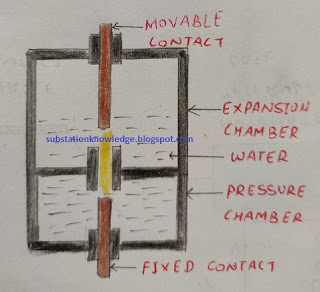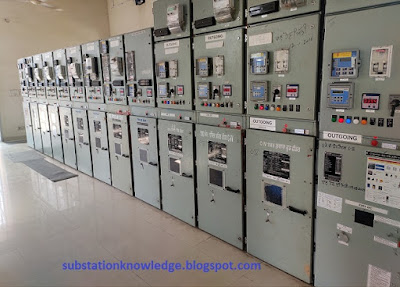WHAT IS EARTHING?ISI SPECIFICATION EARTHING?EARTHING OF SUB STATIONS?
Earthing: Earthing means connecting the metal part of electric equipment by earth.It discharge the all current from metal body, if due to fault (short circuit, broken of live wire etc) live wire come in contact with body of electric equipment.Thus it saves the life of man,who works with these electric equipment.
System of earthing: There are two system used for earthing.These system are described below.
1.Direct earthing system (solid earthing system): In direct earthing system, the earthing electrode directly buried in earth and metal body of electric equipment connected with electrode by earthing wire.It is also known as solid earthing.
Use: This system generally used for earthing of non current carrying body.
→Neutral wire: it is made of galvanized iron, copper wire etc.The resistance of wire should be less.It is mainly green in color.
2.Indirect earthing: In indirect earthing system, the earthing electrode indirectly buried in earth.Means an electric equipment (like: resistance,reactance,impedance coil,potential transformer and current transformer etc) connected between the body and earth electrode.
Use: This system generally used for the neutral point earthing of generator, transformer etc.
Advantages from earthing of electrical equipment: The advantages from earthing of electric equipment is given below.
- At the time of leakage or earth fault, the current from metal body transfer to earth by earthing system.
- The equipment is always connected to earth.So, the earthed body remains at zero voltage.
- The equipment is connected to earth.So, at the time of fault (leakage or earth fault) all the charge transfer to earth.So, we do not receive any electric shock.
- Due to better earthing system, all the protective devices (fuse, earth fault relay etc) works properly at the time of fault and protect the device as well as human life.
Indian Standard Institute (I.S.I) specification regarding earthing:The I.S.I specification regarding earthing of electric installations is given below.
1.Size of earth conductor: The conductor which is used for connecting the metal body to earth electrode is known as earthing conductor.The cross-section area of earthing conductor should not be less than 3 square millimeter (14 s.w.g.).
2.Distance of earth electrode from building: The distance of earth electrode from building should be more than 1.5 meter.
3.Earth resistance: The resistance offered by the earth when current flow in the earth by earthing system is known as earth resistance or earth contact resistance. The value of earth resistance is vary according to weather.Because earth resistance vary according to moisture contain in earth.So, in winter the earth resistance will be less as compared to summer.
→Theoretically the earth resistance should be ZERO.But in practical it is not possible.
According to IS : 3043-1966 the maximum value of earth resistance of electric system is given below:
- Large power station = 0.5 ohm
- Medium power station = 1 ohm
- Small sub station = 2 ohm
- Electric installation = 2.5 to 5 ohm
- Earth conductor = 1 ohm
4.
Same material: The earth wire and earth electrode should be made of same material.Thus the resistance of both the material will be same.
5.Mechanical protection of earth wire: For the protection of earth wire, earth wire should be come out from earth by connecting the earth electrode through galvanized pipe of 12.7 mm diameter and 30.5 cm length.
6.Position of earth electrode: The earth electrode should be placed in vertical position in earth pit.Thus it comes in contact with different layers of earth.
Earthing of electric generating stations and sub-stations:
The earthing of different electric equipment at electric generating stations and substations is given below:
1.Neutral point: The neutral point of electric equipment (transformer, electric generator etc) are should be earthed by direct or indirect earthing system.
The given below image shows the indirect earthing system of the neutral point of power transformer:
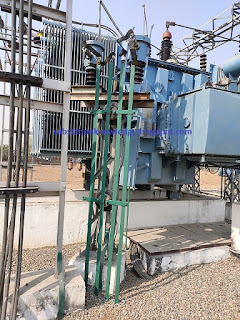 |
| Neutral point or indirect earthing |
2.Lighting arresters: The lighting arresters installed at substation should be earthed.The given below image shows the earthing system of lighting arrester:
3.
Metal body of electric equipment: The metal body of all the electric equipment like transformers, circuit breakers, isolators, panels, tap-changer panel, distribution panel etc install at sub-station should be earthed.
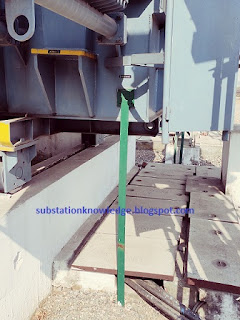 |
| Metal body earthing |
4.
Metallic frames: All the frames (metallic structures) on which electric equipment install should be earthed.
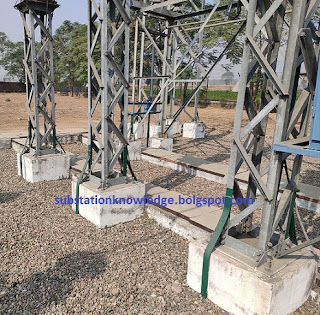 |
| Metallic frame earthing |
Practical value of earth resistance of substation equipment:
In given image the practical value of earth resistance is given below:
 |
| Substation Yard |
Power transformer body - 0.90 ohm
HV neutral - 0.90 ohm
LV neutral - 0.90 ohm
SF6 breaker - 0.31 ohm
Lighting arresters: R - 0.31 ohm Y - 0.31 ohm B - 0.30 ohm
Current transformer: R - 0.31 ohm Y - 0.31 ohm B - 0.30 ohm
These given value of earth resistance is in satisfactory range.Because this data is a medium power substation and value of earth resistance is less than 1.Less the value of earth resistance, more effective is the earthing.
→The earth resistance measured by GROUND RESISTANCE METER or EARTH TESTER or OHM METER.
( In this type of instrument we have three electrodes and we hammer this electrodes in ground.Applying the voltage ( by meter battery) by meter between these electrodes.The current is flow in each electrodes.Thus by the value of current and voltage, meter shows the value of earth resistance with the help of OHM'S Law.
Mainly the current and voltage in each electrode same)
Conclusion: The final conclusion is that earthing of electric equipment is very necessary.Because it protect the life of man at the time of fault and also increase the life of the equipment.



